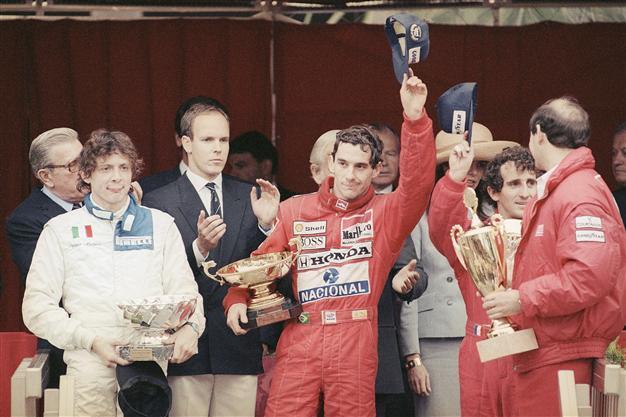Hamilton, Alonso salute legacy of tragic Senna
PARIS - Agence France-Presse

Despite his career being cut short when he was 34, his 41 wins stand third all-time behind Michael Schumacher's 91 and rival Alain Prost's 51. AP Photo
Lewis Hamilton and Fernando Alonso have paid emotional tributes to Ayrton Senna on the 20th anniversary of the death of the maverick Brazilian superstar and three-time world champion.
Senna, widely regarded as the greatest racing driver of all time, died when his car careered off the Imola track in the early stages of the San Marino Grand Prix on May 1, 1994.
He was 34 years old.
It was Formula One's blackest weekend which also saw Austrian rookie Roland Ratzenberger killed and Senna's compatriot Rubens Barrichello injured.
"When I was a kid I had all the books, all the videos, he was the driver I looked up to," said Hamilton, who was just nine at the time of Senna's death.
"He inspired me to be a driver and on the day of his passing, his death was... it was very difficult for me to show my emotions so I went off to a quiet place and it was very difficult for several days to really... your hero's gone."
Senna, the outspoken world champion of 1988, 1990 and 1991, was leading in San Marino on lap seven when his Williams car veered spectacularly off the racing line at 190mph (307km/h) at the Tamburello corner and straight into a concrete wall.
He received emergency treatment at the scene before being airlifted to Bologna hospital where he was later declared dead.
"He was an incredible legend. You like to think that one day you may be recognised as someone that was able to drive similarly to him," added Hamilton, the 2008 world champion.
Alonso, the 2005 and 2006 world champion, was 12 when Senna was killed and the Spaniard vividly recalls the day of the tragedy.
"On my schoolbooks I didn't have pictures of girls, obviously I was too young but I had Ayrton there and the same in my room," said the Ferrari star.
"I had a big poster of Ayrton and even my first go-karts were in the colours of Ayrton's McLaren because my father also liked him. It was a very sad moment."
Senna himself admitted that he feared for his safety in the 1994 season after a series of technical changes were made to a sport which had not seen a fatality since Riccardo Paletti was killed at the Canadian Grand Prix 12 years earlier.
"It's going to be a season with lots of accidents, and I'll risk saying that we'll be lucky if something really serious doesn't happen," warned Senna in a chilling premonition.
He was proved grimly correct at Imola.
On the Friday of the racing weekend, Barrichello's Jordan hit a kerb at the Variante Bassa corner at 140 mph (225 km/h), causing the car to barrel-roll and knocking him unconscious.
Barrichello suffered a broken nose and arm. When he regained consciousness at the hospital in Bologna, the first person he saw was Senna.
Worse was to follow in qualifying on the Saturday when Ratzenberger smashed into a concrete wall after his Simtek car failed to negotiate the Villeneuve curva. The Austrian died in hospital from multiple injuries.
Senna's Williams team refused to take part in the qualifying session with the Brazilian visibly shaken by the death of Ratzenberger.
The race itself started in dramatic circumstances when the cars of JJ Lehto and Pedro Lamy collided on the grid, spewing debris into the grandstands and injuring a number of spectators.
The safety car was summoned to clear the track, fatally cooling the tyres of Senna and the chasing pack as they waited to be released.
Minutes later, the legendary driver suffered the accident which killed him and changed the sport forever.
Professor Sid Watkins, the head of Formula One's race medical team and a close friend of Senna, had tried to persuade the triple champion not to race.
"Ayrton broke down and cried on my shoulder," Watkins recalled in his memoirs.
"I tried to persuade him not to race the following day, asking "What else do you need to do? You have been world champion three times, you are obviously the quickest driver. Give it up and let's go fishing," but Ayrton was insistent, saying, "Sid, there are certain things over which we have no control. I cannot quit, I have to go on."
Senna's death led to a raft of changes to improve safety in the sport.
The Grand Prix Drivers' Association was reformed, engine capacities were reduced and tethers to help prevent wheels flying off following accidents were introduced.
The HANS device to protect drivers' heads and necks were made compulsory, run-offs were extended and improved.
